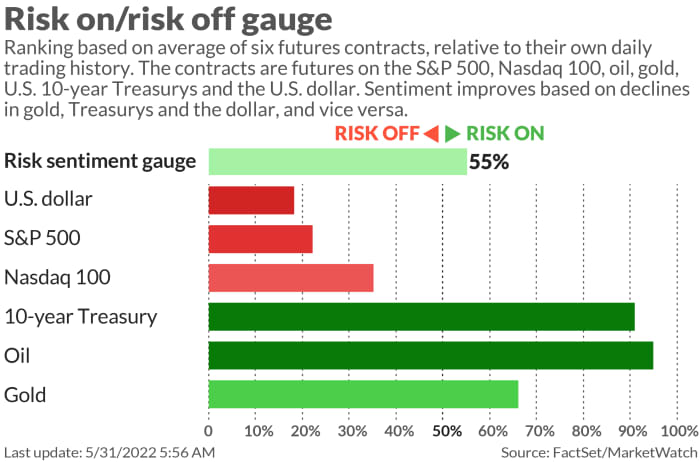The last trading day of May is being marked by weakness in stocks and surging crude prices, climbing after the EU hammered out a partial ban on Russian oil imports after that country’s invasion of Ukraine four months ago.
That brings us to our call of the day from Goldman Sachs, who sees a budding “there-is-no-alternative” trade in commodities.
As a team led by Goldman’s head of commodities research, Jeffrey Currie, explains, there are few alternatives out there for hedging macro risks as central banks hit the brakes to try and control inflation. Equities are now negatively correlated with inflation expectations, suggesting investors are even more worried about the risk to stocks and valuations.
“As central bankers can drain liquidity faster than the economy can generate new production capacity, financial assets will continue to underperform physical assets like commodities,” said Currie. So convinced is Goldman, the bank’s portfolio strategy team is keeping overweight recommendations only on commodities and cash for the next quarter.
Goldman Sachs Global Investment Research
“Indeed, across major risk assets, commodities are the only source of value, despite clear headwinds from Chinese lockdowns, slowing manufacturing and rising rates,” said Currie, who adds that it isn’t a “crowded trade” either. They estimate net flows into index funds have flattened since November 2021, as investors took profits in the aftermath of the Russian invasion.
Goldman sees the next leg higher for prices coming from hoarding across the space. From early April to mid-May, for example, China lockdown restrictions pushed commodity fundamentals into recession, yet prices held up, they note.
“As we saw in gasoline markets in 2006, when investors appear after a period of scarcity and volatile prices, market participants — from refiners to manufacturers — begin to hoard the spare stocks as a hedge against future scarcity,” said Currie and the team.
“This creates backwardated markets despite building inventories and signals a strong set up for the next leg higher, as Chinese stimulus pressures continue to build and consumers continue their rotation toward higher travel and leisure spending,” he added.
This is being seen across commodities right now, with Russia’s invasion of Ukraine triggering a behavioral shock that has driven policy makers and upstream manufacturers to try and build thicker and more resilient supply chains, and precautionary stocks of everything from soybeans to crude. And that’s as China tries to get its economy back up and running after lockdowns.
Goldman blames a lack of big inflows to commodities on heightened investor uncertainty across the economy, but even if a softer macroeconomic picture is confusing investors, scarcity conditions for many commodities aren’t going away, they say.
“Though muddled macro risks are more two-sided today than in the immediate aftermath of the invasion, now is not the time to shift expectations for commodities outperformance, in our view,” the Goldman team said.
They are forecasting a 21% return for the iShares S&P GSCI Commodity-Indexed Trust GSG on a 12 month view.
“With inventories and spare capacity still low across energy and agricultural markets, any small shock to supply will continue to have outsize impacts on prices,” said Goldman. “As we have often shown before, commodities are the only consistent hedge for unexpected inflation, usually as the source of it in the
economy.”
“Accordingly, even a small allocation to commodities can have a material
impact on a portfolio’s performance during unexpected inflationary episodes,” said Currie and the team.
The buzz
President Joe Biden will meet with Federal Reserve Chair Jerome Powell on Tuesday to discuss the economy, in the first meeting between the two since November. In an op/ed for The Wall Street Journal, Biden promised not to meddle in Fed policy.
Elsewhere, Federal Reserve Gov. Christopher Waller said Monday that half-point rate hikes will continue until inflation subsides. U.S. data ahead Tuesday includes a pair of home-price indexes for March and consumer confidence for May.
Yamana Gold AUY shares are surging after Gold Fields GFI announced a $6.7 billion deal for the Canadian miner.
China factory and service-sector activity improved in May, though activity was slower due to COVID lockdowns, which are starting to ease up in Shanghai and Beijing.
While U.S. politicians remain at odds over gun-control efforts, nearly a week after 19 children and two teachers died in the country’s second-deadliest school shooting, Canada plans to ban the purchase and sale of handguns.
The markets

Uncredited
U.S. stock index futures ES00 YM00 ES00 are lower, while Treasury yields BX:TMUBMUSD10Y BX:TMUBMUSD02Y are climbing on those comments by Fed’s Waller. Diesel fuel prices HOM22 are up about 4%, and both U.S. and Brent crude CL BRN00 are headed for the longest monthly winning streaks since 2011. Among cryptos, bitcoin BTCUSD is back above $31,000 for the first time since early May.
Read: Investors want this asset inflation stays high, says Deutsche Bank. And crypto isn’t even ‘on the radar’
The tickers
These were the top-traded tickers on MarketWatch as of 6 a.m. Eastern:
The chart
Random reads
Spanish man builds his own cathedral
Women get more out of a morning workout, while men are the opposite.
Need to Know starts early and is updated until the opening bell, but sign up here to get it delivered once to your email box. The emailed version will be sent out at about 7:30 a.m. Eastern.
Want more for the day ahead? Sign up for The Barron’s Daily, a morning briefing for investors, including exclusive commentary from Barron’s and MarketWatch writers.

